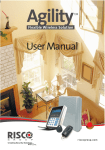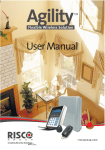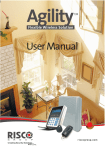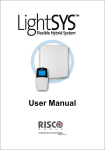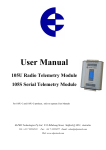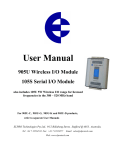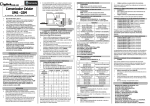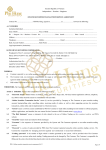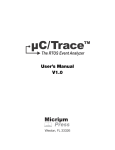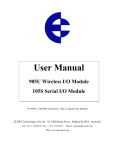Download User Manual - Mono Alarms
Transcript
User Manual Agility User Manual Important Notice This guide is delivered subject to the following conditions and restrictions: This guide contains proprietary information belonging to RISCO Group. Such information is supplied solely for the purpose of assisting explicitly and properly authorized users of the system. No part of its contents may be used for any other purpose, disclosed to any person or firm, or reproduced by any means, electronic or mechanical, without the express prior written permission of RISCO Group. The information contained herein is for the purpose of illustration and reference only. Information in this document is subject to change without notice. Corporate and individual names and data used in examples herein belong to their respective owners. All rights reserved. © 2008 RISCO Group August 2008 Page 2 Agility User Manual Table of Contents Chapter 1 - Introduction ..............................................................................................................5 1.1 Main Features......................................................................................................................5 1.2 Agility Architecture...............................................................................................................6 1.3 User Operating Tools ..........................................................................................................7 1.4 Status Indications ................................................................................................................8 LED Indicators ..................................................................................................................8 Status Button / Service Call (Listen & Talk)......................................................................9 Voice Messaging...............................................................................................................9 SMS Messaging................................................................................................................9 Email Messaging...............................................................................................................9 Sound Indications ...........................................................................................................10 Chapter 2 - Local System Operation........................................................................................11 2.1 Setting your system ...........................................................................................................11 Full setting.......................................................................................................................11 Part setting......................................................................................................................12 Partition setting ...............................................................................................................12 Force setting ...................................................................................................................13 Setting with faults in the system .....................................................................................13 2.2 Unsetting your system .......................................................................................................14 System unsetting ............................................................................................................14 Partition unsetting ...........................................................................................................14 Duress unsetting .............................................................................................................15 Unsetting after an alarm .................................................................................................15 Resetting after an alarm .................................................................................................16 Anti Code Reset……………………………………………………………………………. 16 Engineer Reset… …………………………………………………… …………………..16 2.3 Sending a Panic Alarm ......................................................................................................17 Chapter 3 - Remote System Operation ....................................................................................18 3.1 Remote Phone Operation..................................................................................................18 Remotely Accessing the System ....................................................................................18 Voice Operations Menu ..................................................................................................18 Receiving Calls from the System ....................................................................................19 Acknowledge Menu.........................................................................................................20 Bi-directional Communication .........................................................................................20 3.2 SMS Operation ..................................................................................................................21 SMS Remote Control ......................................................................................................21 SMS Confirmation Message ...........................................................................................22 Chapter 4 - User Functions and Settings ................................................................................23 4.1 User Codes........................................................................................................................23 4.2 Proximity Tags...................................................................................................................25 4.3 Defining Follow Me Destinations .......................................................................................26 4.4 Scheduler ..........................................................................................................................28 4.5 Complete Menu of User Functions ....................................................................................29 Chapter 5 - System Specifications...........................................................................................32 Chapter 6 - EN 50131 Compliance ...........................................................................................33 Page 3 Agility User Manual Page 4 Agility User Manual Chapter 1 - Introduction Congratulations on your purchase of Agility ‐ RISCO Groupʹs Flexible Wireless Security System. The Agility has been specifically designed to meet a wide range of security, safety and home automation needs for many residential and commercial applications. Agility is designed to recognize abnormal conditions and inform the system of the status of any protected door, window, hallway, room, or area. Status information is presented visually or verbally. It supports the capabilities of communicating with an Alarm Receiving Center (ARC) or to your mobile phone using friendly and easy to understand verbal messages as well as SMS or E‐mail messages. This manual describes how to operate your system. It will guide you through programming instructions for main system features as well as basic setting and unsetting commands for the system. 1.1 Main Features Up to 32 wireless zones (1 way or 2 way wireless detectors) + 4 optional wired zones (only with I/O expander) 32 User codes + Grand Master code 4 fixed authority levels for user Proximity tag for each user 3 partitions 3 wireless keypads (1 way or 2 way) 3 wireless sounders (internal or external) 8 Remote controls (1 way or 2 way) 250 Events Log 16 Follow Me destinations 4 outputs (I/O expander) X‐10 support Page 5 Agility User Manual 1.2 Agility Architecture Your Agility controls and monitors a variety of sensors, detectors, and contacts placed throughout the premises, which provide external, perimeter and internal burglary protection. The system is supervised, meaning that the panel checks the status of each sensor to detect problems. If the panel detects a fault it will notify you with beeps and indicator lights on the panel itself. The following diagram shows the components that make up the system: Page 6 Agility User Manual 1.3 User Operating Tools The Agility system can be operated using several devices, some of which have been designed as bi‐directional. If you have purchased a bi‐directional device your system is capable of sending a return reply status indication from the panel to the device for each command that is sent to it. Depending on your purchase you can operate your system via the following: 2‐Way 8 Button Remote Control: Using the bi‐directional 8 button remote control you can set, unset, send a panic alarm, activate outputs and more. Being bi‐directional the remote control receives a reply status indication, via its 3 colored LEDs and internal buzzer sounder, from the panel for each command that it has sent to the panel. For higher security, commands can be defined to be activated with a 4 digit PIN code. Agility 2‐Way Wireless Keypad: Using the bi‐directional wireless keypad you can program and operate your system according to your needs. Being bi‐directional the keypad receives a reply status indication from the panel for each command that it has sent to the panel. To use functions of the keypad you can use a code or a proximity tag. 4 Button Key fob: Using the 4 button key fob you can set, unset, send a panic alarm and activate outputs. Remote Phone Operation: Using any remote, touch‐tone phone you can perform remote operations such as setting, unsetting, listening in and talking to the premises and more. The system can also provide audible information such as event occurrences and the status of your system. If your system is equipped with a GSM/GPRS module it can provide information about the system such as event occurrences by SMS. You can also operate the system using SMS commands for setting and unsetting the system and more. SMS: Configuration Software: RISCO Groupʹs Configuration Software enables the engineer to program the system and operate the system locally or remotely. Web Browser: Using the web you can perform a variety of operations on your system such as setting, unsetting, output activation, receive status information and viewing event logs. Page 7 Agility User Manual 1.4 Status Indications LED Indicators The LED indicators provide typical system indications, as discussed below. Some indicators have additional functions, which are explained later on. Power LED The Power LED indicates system operation. Condition Description On Rapid flash Slow flash Power OK Indicates AC fault Indicates low battery fault Set/Alarm LED (Red) Condition Description On Rapid flash Slow flash System set Alarm System in Exit delay Part Set LED Condition Description On Off System set at PART SET System unset Ready LED (Green) Condition Description On Off Slow Flash System ready Open zones System is ready to be set while a specially designated entry/exit door remains open Fault LED Condition Description Rapid Flash Off Fault No fault Note: When all LEDs flash one after another in sequence the system is in Installation mode. Page 8 Agility User Manual Status Button / Service Call (Listen & Talk) The button on the main unit can be defined as a system status indicator or as a S.O.S button. Once pressed, a service call will be established to the ARC, which then enables 2‐way communication with the premises. Voice Messaging Three types of spoken messages are heard when using the Agility, locally in the premises or remotely to your mobile: Event messages: Upon selected event occurrence, the Agility initiates a call to a remote Follow Me (FM) telephone number, informing you of a security situation by playing a pre‐recorded Event announcement message. Status messages: Upon remote access of the system by initiating a call from a remote telephone or receiving a call from the system, the Agility announces the current system status by playing a pre‐recorded Status message. Local Announcement messages: Upon event occurrence or user’s keypad operations, the Agility can announce various local messages to residents. SMS Messaging Using the GSM/GPRS Module the system can send predefined SMS event messages to a remote Follow Me (FM) telephone number, informing you of the status of the security system and certain events that occurred in the system. For example: Email Messaging Using the Agility IP Module the system can send event messages by Email to predefined e‐ mail addresses informing you of the status of the security system and certain events that occurred in the system. For example: Subject: Alarm Security Message: Intruder Alarm System Name: Johnʹs Residence Event: Fire Alarm, Zone 5, Entrance door Time: 01 April 2008; 16:12 Partition: Partition 1, First floor Service Contact: ARC 01, 03‐5676778 Page 9 Agility User Manual Sound Indications In addition to the visual indications provided by the Agility’s LEDs, your system produces audible notification after certain events. Condition Description Intrusion alarm Fire alarm Exit delay Entry delay Confirm operation Reject operation Set/Unset squawk Continues rapid beeping Staggered rapid beeping Slow buzzer beeps until the Exit Delay time period expires Slow buzzer beeps until the Entry Delay time period expires. A one‐second tone Three rapid error beeps 1 sounder chirp: System set 2 sounder chirps: System is unset 4 sounder chirps: System unset after an alarm Page 10 Agility User Manual Chapter 2 - Local System Operation 2.1 Setting your system Setting your system causes the intrusion detectors to trigger an alarm when violated. The setting operation will be followed by a local message announcement (if defined). Before setting the system check the Ready LED and make sure that the system is ready to be set. If the system is NOT ready to be set secure or omit the violated zone(s), and then proceed. Failing to set the system will be indicated by the system Your Agility offers the following kinds of setting: Note: If you are unable to set the system, press the status key to view system messages. Full setting: Full setting prepares all of the systemʹs intrusion detectors to activate an alarm if violated, and is used when leaving the premises. The system will set after the designated countdown time (Exit delay) and a local message will sound. Once you have set the system, exit via the designated final exit door. To set using Full setting procedure Quick mode: High security mode: Press Quick mode: + code High security mode: + code or proximity tag Press± Send SMS : [Code][S], example, 1234S Page 11 Agility User Manual Part setting: Part setting activates only perimeter detectors (as defined by your engineer), enabling individuals to remain inside and move about the premises while the system is partially set. To set using Part setting procedure Quick mode: + code High security mode: Quick mode: High security mode: + code or proximity tag Press ± button or button 4 (if defined. Advise with your engineer) Partition setting: One of the Agilityʹs advantages is its ability to divide the system in up to 3 partitions. Each partition may be managed as a separate security system, each of which can be set and unset individually regardless of the condition of the other. Partitions can be set or unset one at a time, or all at once, and each partition can be set at Part Set or Full Set. Only users that have been defined to operate multiple partitions can operate more than one partition and set/unset all partitions at once. To set using Partition setting (Full Set or Part Set) procedure Quick mode: / / High security mode: Quick mode: / High security mode: / / > / / > > / / / / > / + code + code or proximity tag Press ± button or button 4 (if defined. Advise with your engineer) Send SMS: [Code][ S] [Partition 1,2 or 3]. Example 1234S1. Fore more information refer to page 21. Page 12 Agility User Manual Force setting: Force setting sets the system regardless of open zones. Your engineer must enable this option. Note: Force setting the system results in leaving part of the system unsecured. Setting with faults in the system If required, and defined by your engineer, all faults in the system should be confirmed to enable the setting operation while performing setting from the wireless keypad. When trying to set the system with faults, the display will show a ʺSystem Faultsʺ key to view the faults in the system. Scroll down the faults list message. Press the to view all faults in the system. To enable one time setting from the keypad: and enter your user code to access the user menu. 1. Press 2. Go to Activities > Omit Fault 3. The following question will appear: ʺOmit Faults. Are you sure? N?ʺ. Using the 4. key change to Y and press to confirm. Press to return to main display and perform the setting operation again. Page 13 Agility User Manual 2.2 Unsetting your system Unsetting your system causes the detectors not to trigger an alarm when violated. When you enter the premises, the Entry Delay begins to count down. You must unset the system within the Entry Delay time to prevent the system from triggering an alarm. The unsetting operation will be followed by a local message announcement (if defined). Note: If an alarm occurred in the system, it is recommended to leave the premises. Only after police investigation should you consider that the burglar is no longer on your premises and you can re‐enter. In special cases (if programmed by your engineer) setting the system after an alarm might require a technician code. For more information refer to your engineer Your Agility offers the following kinds of unsetting: System unsetting: Unsetting deactivates the partitions assigned to the specified user code To unset using Procedure for Unsetting . All partitions assigned to the button will be unset Quick mode: High security mode: Press > Code followed by code or proximity tag. Press the ² button. All partitions assigned to the button will be unset. Send SMS: [Code][U], example 1234U Partition unsetting: Partition unsetting enables you to unset individual partitions within an set system To unset using Procedure for Partition Unsetting Quick mode: / / High security mode: / / > > / / > > Code > code or proximity tag. Page 14 Agility User Manual To unset using Procedure for Partition Unsetting Press the ² button. All partitions assigned to the button will be unset. Send SMS: [Code][U] [Partition 1,2 or 3]. Example 1234U1. Fore more information refer to page 21. Duress unsetting: If you are ever coerced into unsetting your system, you can comply with the intruderʹs wishes while sending a silent duress alarm to the Central Station. To do so, you must use a special duress code, which when used, will unset the system in the regular manner, while simultaneously transmitting the duress alarm. Confer with your engineer which of the userʹs codes is defined as a duress code. Note: Under no circumstances must the duress code be used haphazardly or without reason. Central Stations, along with Police Departments, treat duress codes very seriously and take immediate action. Unsetting after an alarm: When silencing an alarm the system goes into an unset state. After the system is unset the sounders will sound 4 sounder chirps indicated that an alarm occurred in the system. If an ʺEntry doorʺ is opened prior to unsetting the system, the following voice announcement message will be heard: Alarm occurred in the systemʺ. Press the key will indicate the cause of the alarm. Note: If an alarm occurred in the system, it is recommended to leave the premises. Only after police investigation should you consider that the burglar is no longer on your premises and you can re‐enter. In special cases (if programmed by your engineer) setting the system after an alarm might require a technician code. For more information refer to your engineer. Your engineer can define the number of times (0‐15) that an alarm will be sent from the same detector during one setting period. This is usually used to prevent an alarm from a malfunction detector, an environmental problem or incorrect installation Page 15 Agility User Manual Resetting after an alarm: Your installation company can define that the reset of the system to a Normal Operation mode will require the intervention of your ARC or engineer. In this case, after an alarm condition the system will be regarded as Not Ready and while requesting for system status ( Reset. )indication you will get a fault message: Technician Anti Code Reset 1. Press . Enter user code Go to Activities > Anti Code option. 2. Call your ARC or engineer and quote the “RANDOM CODE” displayed on your keypad. The ARC or engineer will give you a return Anti‐Code. 3. Enter this Anti code followed by and the system will reset. Engineer Reset Your ARC or engineer can reset your system remotely or locally from the keypad. To enable local reset by your engineer you may need to authorize him using the master code after the engineer enters his code. A one hour time window is opened for the engineer to program user functions and be able to reset your system locally Page 16 Agility User Manual 2.3 Sending a Panic Alarm Panic alarms enable you to send a message to the ARC in the event of an emergency, send a message to a follow me number, announce a local message or activate a local alarm. Panic alarms can be set to be silent (Refer to your engineer for more information). To send a Panic Alarm using Procedure Press both and Press both and keys simultaneously keys simultaneously Note: Your engineer should define these keys to be set as panic keys. These keys can be either disabled or used to establish a service call to your ARC. If defined by your engineer pressing simultaneously for 2 seconds will send a fire alarm and pressing simultaneously for 2 seconds will send a special emergency or medical alarm. Press the small blank button (if defined) Note: Your engineer can define the small blank button to be used for sending a panic alarm. Note: For full capabilities of the 2‐way remote control, the bi‐directional keypad and 4 button key fob, refer to the instructions supplied with each product. Press both keys simultaneously Press the panic button Page 17 Agility User Manual Chapter 3 - Remote System Operation 3.1 Remote Phone Operation The Agility enables you to operate the system from a remote touch‐tone phone by initiating a telephone call to or from the system and interacting with voice menus that guide you through your required remote operation. Remotely Accessing the System Remotely accessing the system involves initiating a call to the system, and entering your remote access code and the user code you usually enter in the system keypad. To remotely access the system: 1. From a remote touch‐tone telephone, dial the number of the premises where Agility is installed. 2. If your system is connected to a land telephone line and an answering machine is in use at the premises let the line ring once, then hang up and call again. If an answering machine is not in use at the premises wait until the system picks up. After the system picks up a short tone is heard. Note: When the system picks up, all phones on the same line are effectively disconnected and cannot be used. 3. Enter your 2 digit remote access code within 10 seconds (Default code = 00). The following message is announced: ʺHello, Please Enter Your User Code, Followed By [#]ʺ. Enter your user code followed by [#]. (Default code=1234) 4. After your code is accepted a system status message is announced, followed by the Operations menu. You can now perform the required remote operations. Voice Operations Menu The Voice Operations menu announces options and instructions on how to use the system functions. The options in the Operations menu vary according to system status and your access rights. Following is a list of the remote operations options: Operation Quick Key Combination Setting all partitions Press [1][1] Setting a selected partition Press [1][9] followed by the partition number Unsetting all partitions Press [2][2] Unsetting a selected partition Press [2][9] followed by the partition number Page 18 Agility User Manual Operation Quick Key Combination Changing Zone Omit status Press [3] followed by the zone number and then [#][9] Operating Programming Outputs Press [4] followed by the output number Changing Follow Me(FM) numbers Press [5] followed by the FM number and [#][2]. Enter the new phone number and press [#][1]. Listen in to the premises Press [6][1] Talking to the premises Press [6][2] Listen and Talk to the premises Press [6][3] Recording an opening message Press [7][1] Recording messages that are not included in the message bank (5 messages) Press [7][2] Exiting the System Press [0] To return to the previous menu Press [*] To repeat the menu options Press [#] Receiving Calls from the System Upon event occurrence, such as alarm activation, the system informs you of security situations, for example, intrusion or fire, by calling you and announcing a pre‐recorded event announcement message, followed by the Acknowledge menu. The system can call up to 16 Follow Me numbers, enabling you, a relative or neighbor to be informed of the security situation. You can then take the appropriate action, whether this is to inform the authorities or acknowledge the event and remotely operate the system. Notes: Follow Me messages are performed only after reporting to the ARC. Follow Me numbers are assigned certain events for which they receive calls. The system must be programmed to call a FM number after a specific event occurs in order for that event to trigger the call. To receive an event call: 1. 2. Pick up the phone. Say ʺHelloʺ or press [#]. The Event Announcement message is made, informing you of a security situation in your system, for example: “24 Oaklands Street, Intruder alarm, Ground Floor, kitchen” Notes: If no voice is detected, the event message will start playing 5 seconds after phone pick up. Press [#] to begin playback of the event message from the beginning. To repeat the Event Announcement message press [#]. To omit the Event Announcement message and go directly to the Acknowledge menu, press [*]. 3. Acknowledge the event. (See Acknowledge Menu) Page 19 Agility User Manual Acknowledge Menu After the Event Announcement message is made, the following list of options is announced: Operation Digit Acknowledge Message Acknowledging an event means that you have received a message from the security alarm system about a relevant event in the system and want to confirm this. After you acknowledge an event, the system calls the next FM number. Press [1] Acknowledge and stop all dialing This option acknowledges the event and stops the system from calling the next FM numbers to report the event. Press [2] followed by the code Acknowledge and access the Operations menu The Operations menu lists the available options for remotely operating your system. Press [3] followed by the code Listen In and Talk This option enables you to perform bi‐directional communication. Press [6] followed by the code Repeat the event message Press [#] Repeat the Acknowledge menu Press [*] Note: If an invalid code is entered 3 consecutive times, the system hangs up and this FM number is locked for 15 minutes and no calls are initiated to the FM number. If a valid user code is not entered within 10 seconds, the system hangs up. Bi-directional Communication The Listen In and Talk options enable you to remotely and silently listen in to your premises in order to verify the cause of an event occurrence, through the microphone or remotely talk to your premises via the Agility loudspeaker, for example, to guide someone in distress. To listen in or talk: 1. From the Operations/Acknowledge menu, press [6]. The following messages are announced: “To Listen In press 1, To Talk press [2], To Listen and Talk (Open channel) press [3], To return to the previous menu, Press [¾].” 2. Select the desired option. 3. Press [¾] to end listening in and talking communication and return to the Operations menu. Page 20 Agility User Manual Bi-directional Audio Options after an Alarm In the event of Burglary, Fire and Medical alarms, the Agility is able to report these events and then stay on the line. This allows the monitoring service to perform Voice Alarm verification, verify the alarm or Verification in order to verify a cause of event or guide someone in distress. Service call The Service Call feature enables you to call the ARC by pressing a key. To establish the service call, press the button on the main unit or press simultaneously the buttons the bi‐directional keypad. on Note: The Service call should be defined by your engineer. 3.2 SMS Operation SMS Remote Control The Agility enables you to perform remote control operations using simple SMS commands. The following section describes the SMS commands and the response of the system to these commands. Note: This application is available only if a GSM/GPRS module is installed in your system. Operation Set all partitions of a user code SMS Message Structure [Code] S Example 1234S Unset all partitions of a user code [Code] U 1234U Set by partition [Code] S [Partition No.] 1234S1 Unset by Partition [Code] U [Partition No.] 1234U1 Omit a zone [Code] O [zone number] 1234O05 Un‐omit a zone [Code] PO [zone No.] 1234PO05 Activate Output [Code] POON [PO No.] 1234POON1 Deactivate Output [Code] POOFF [PO No.] 1234POOFF1 Change FM number [Code] FMPHONE [FM serial number] NEW [New Phone No.) 1234FMPHONE 3 NEW0529692345 Get system status [Code] ST 1234ST Get last alarm memory [Code] AL 1234AL Get SIM credit level (for prepaid cards) [Code] CR 1234CR Page 21 Agility User Manual Notes: SMS commands can be sent from any mobile phone or from an SMS website. Command words are not case sensitive. A separator between command words is not required although it is accepted. SMS Confirmation Message A confirmation message following a SMS operation is sent to the user, upon request, by adding the letters “RP” at the end of the SMS messages listed below. Example: 1234 A RP ‐ A confirmation message following a setting operation will be sent to the user. Confirmation or Fail operation messages can be assigned to the actions of setting, unsetting, omitting, activating outputs or changing follow me definitions. Page 22 Agility User Manual Chapter 4 - User Functions and Settings The functions and settings explained in this chapter can only be performed via your keypad and the Configuration Software. This chapter refers to these functions and settings as performed via the keypad. Refer to the Configuration Software manual for more information regarding how these functions and settings are performed via the Configuration Software. When using the keypad during the programming mode use the following table to be familiar with the functionality of the keys: Function Sequence Exits from the current menu Terminates commands and confirms data to be stored Used to browse through the menu: Scrolls up a list or moves the cursor Changes data Numerical keys are used to input the numeric codes that may be required for setting, unsetting, or used to activate specific functions 4.1 User Codes To perform many of the Agility functions, a security code (often called a user code) must be used. Each individual using the system is assigned a user code, which, in turn, is linked to an Authority Level. Those with a ʺhigher authorityʺ have access to a greater number of system functions, while those with a ʺlower authorityʺ are more restricted in what they may do. There are four different authority levels available for users of the Agility. Notes: To define the authority levels refer to your engineer. Agility can support up to 32 different user codes. User codes may have variable lengths up to 6 digits. Your Agility was given a Grand Master Code of 1‐2‐3‐4 during manufacturing. Unless your alarm company has already changed it to suit your preference, itʹs best to modify this code to one that is unique and personalized as herein described. Page 23 Agility User Manual Setting / Changing User Codes The user assigned the Grand Master authority level can change all user codes but cannot view the digits in the user code fields. Users with other authority levels can only change their own codes. The system must be unset in order to set or change user codes. To set/change a user code: 1. Press 2. Enter your code 3. Using the arrow keys, scroll to the option Codes/Tags from the User Functions menu and press Note: If you enter a wrong user code, the keypad produces 3 short beeps and the ʺWrong Code. Please Try Againʺ message will be heard. Press quickly and re‐enter the above sequence correctly. 4. You will see the option New/Change. Press 5. Using the arrows scroll to select the User Index number to which you want to assign a user code and press . Note: In the Agility system, the User Index number is from 00 to 32, where 00 belongs to the Grand Master. 6. Enter the new code and then re‐enter the code. If successful, a single confirmation beep is sounded, if not, 3 quick error beeps are sounded 7. Repeat the above steps for additional codes until you have completed your list Deleting User Codes At times, you may want to completely delete a user code. Note that it is impossible to delete the Master Code (although it can be changed). The system must be unset in order to delete user codes. To set/change a user code: 1. Follow steps 1‐3 of the previous procedure (See Setting/Changing User Codes) 2. 3. Scroll the menu to the option ʺDelete By Userʺ. Press Using the arrows scroll to select the User Index number which you want to delete and press . 4. The display will show: ʺDelete User. Are you sure?ʺ. Use the 5. . If successful, a single confirmation beep is sounded, if not, 3 [Y] and press quick error beeps are sounded Repeat the above steps for deleting additional codes Page 24 key to select Agility User Manual 4.2 Proximity Tags The bi‐directional keypad enables you to replace the use of a code with a proximity tag to set and unset the security system or to activate and deactivate home appliances and utilities, such as heating and lights. Proximity tag programming is performed from the User Functions menu. When programming a proximity tag, the following three options are available: Adding a new tag Deleting a tag by the user serial number Deleting a tag by the user tag Adding a Proximity Tag The Grand Master can assign a tag to any user in the system. Each proximity tag can be assigned to only one user. To add a proximity tag: 1. Press 2. Enter your user code 3. Using the arrow keys scroll to the option Codes/Tags from the User Functions menu and press . 4. Scroll to Proximity Tags and press 5. Select the option New/Change. Press 6. Using the arrows scroll to select the User Index number to which you want to assign a tag. 7. Within 10 seconds, hold the proximity tag at a distance of 1 to 2 cm. from the keypad’s keys. The keypad automatically reads the proximity tag and saves it into the system’s memory. Once the proximity tag has been successfully recorded, a long confirmation beep sounds, and a confirmation message is displayed. If the proximity tag is already stored in the system’s memory, 3 error beeps will sound and a reject message will appear. Page 25 . Agility User Manual Deleting a proximity tag Deleting proximity tags can be done by in two options: By user number: Use this option to delete a tag for which the user is known By tag: Use this option to delete a tag for which the user is not known To delete by user: 1. Follow steps 1‐4 of the previous procedure (See Setting/Changing User Codes) 2. 3. Scroll the menu to the option Delete by user. Press Using the arrows scroll to select the user for which you want to delete the proximity tag and press 4. . The display will show: ʺDelete User. Are you sure?ʺ. Use the key to select . If successful, a single confirmation beep is sounded, if not, 3 [Y] and press quick error beeps are sounded. To delete by tag: 1. Follow steps 1‐4 of the previous procedure (See Setting/Changing User Codes). 2. 3. Scroll the menu to the option Delete by tag. Press Within 10 seconds, approach the proximity tag at a distance of 1 to 2 cm. from the keypad’s keys. A confirmation message will be displayed. 4.3 Defining Follow Me Destinations In the case of an alarm or event, the system can initiate a phone call to a designated telephone, send a SMS or send an E‐mail and employ unique tones or messages to express the active event. To enter/edit a Follow Me number: 1. 2. Press Enter your user code 3. Scroll the menu using the arrow keys to the option Follow Me and press 4. Select the Follow Me index number you want to edit and press 5. 6. Press to enter the Define menu. Enter the phone number, including the area code (if required) or an e‐mail address, as requested on the screen and press . Up to 32 digits can be included in the phone number. 7. If required, include the special functions described below to achieve the related effect. You can press the or keys to toggle to the required character. Page 26 Agility User Manual Results Function Stop dialing and wait for a new dial tone W Wait a fixed period before continuing , Send the DTMF ¾ character ¾ Send the DTMF # character # Delete numbers from the cursor position 8. When done with your complete entry, press Page 27 simultaneously to store it. Agility User Manual 4.4 Scheduler The Agility enables you to automate some system operations. This is performed by defining weekly programs by your engineer. Each program can be defined with up to two time intervals per day, during which the system automatically performs one of the following functions: Automatic Setting/Unsetting: An setting program automatically sets and unsets the system during your required time intervals. Automatic PO Activation: A PO (home appliance) activation program automatically activates and deactivates POs during your required intervals. In addition, each program can be defined to be activated in a different manner during vacation. Once your engineer defines a schedule program it will be activated. You have the option to deactivate a program according to your needs. To disable a weekly program: 1. Press 2. Enter your user code 3. Scroll the menu using the arrow keys to the option Clock and press 4. Press 5. Select the Scheduling program index number. Use the to enter the Scheduler menu. deactivate and press . Page 28 key to activate / Agility User Manual 4.5 Complete Menu of User Functions The Agility comes with a variety of selectable user functions that become available when you enter the User Functions mode. The following section lists these functions. Note: Although these functions are in the User Functions menu, you can ask you engineer to program them for you. To enter the User Functions mode press followed by your user code. The following table shows full Keypad Operations according to users. √ ‐ User is able to perform this function ‐ ‐ User is unable to perform or see this function Operation Grand Master User Engineer √ √ ‐ Main Buzzer ON/OFF: Used to control the main unit buzzer. √ √ √ Walk Test: Used to easily test and evaluate the operation of selected zones in your system √ ‐ √ Output Control: Allows user control of previously designated external devices (e.g. an appliance, a motor‐driven garage door, etc.) Output Control Æ Select OutputÆDefine [Y] √ √ ‐ Omit Faults: Used to confirm all faults in the system in order to enable setting operation. √ √ ‐ Anti Code: If defined by your engineer the Agility can be defined to be not ready to Set after an alarm or tamper condition. To restore the system to Normal Operation mode, engineer code or an Anti‐ code must be entered. Entering the code supplied by the engineer at this location will restore the system to the Normal Operation mode √ √ ‐ Activities Omit Zone: Provides the ability to omit any of the systemʹs intrusion zones. Omit zone Æ Select zone Æ Define [Y] using the key and press using the key and press Page 29 Agility User Manual Operation Grand Master User Engineer Advanced ÆPrepaid SIM Æ Check Credit Use this function to receive information by SMS or Voice of the credit level in your prepaid SIM card. For more information refer to your engineer. √ ‐ ‐ Advanced ÆPrepaid SIM Æ Reset SIM After charging a prepaid SIM card, the user has to reset the SIM Expire Time manually. The time duration for expiration is defined by your engineer. √ ‐ ‐ Advanced Restore Alarm: The user must approve an alarm that occurred in the system. After unsetting an alarm, an Alarm Memory Display will appear on the screen. Restore Fault: If defined by your engineer, use this option to reset a fault condition after it has been corrected. √ √ ‐ Sounder TMP Mute: Used to silence an alarm initiated by a tamper from a sounder for 20 minutes. Use this option when replacing the sounder battery. √ ‐ √ View IP Address: Use this option to view the IP address of the Agility. √ Define: Used to define Follow Me destinations phone number or Email address according to its type: Voice message, SMS or E‐mail √ ‐ √ Test FM: Used to test Follow Me reporting. √ ‐ √ √ √ ‐ √ ‐ √ Activities Follow Me Codes/Tags Use this menu to set tags and user codes in the system. For detailed information refer to Chapter 4, page 23. Clock Time & Date: Allows the setting of the system time and date. This definition is required for setting the scheduler programming in the system. Page 30 Agility User Manual Operation Grand Master User Engineer Scheduler: Enables you to activate or deactivate preprogrammed schedules that were defined by your engineer. Up to 8 weekly programs can be defined in the system during which the system automatically sets / unsets or activates programming outputs. √ ‐ √ Event Log To view a list of system events that have occurred √ ‐ √ Service Information Allows the display of any previously entered service information. (Name and phone) √ √ ‐ Activities Page 31 Agility User Manual Chapter 5 - System Specifications The following technical specifications are applicable for the Agility: Electrical Characteristics System Power 230VAC (‐15%+10%), 50Hz, 50mA Optional: 9VAC, 9VA, 50‐60Hz Units Consumptions Main board: Typical 130mA GSM: Stand by 35mA, Communication 300mA Modem: Stand by 20mA, Communication 60mA IP Card: 90mA (Max) Backup Battery Sealed Lead Acid Battery 6V 3.3Ah Battery Dimensions (HxWxD) 67mm x 134mm x 34mm Internal Sounder intensity 90 dBA @ 1m Operating Temperature ‐10°C to 40°C (14°F to 104°F) Storage temperature ‐20°C to 60°C (‐4°F to 140°F) Physical Characteristics Dimension (HxWxD) 268.5 mm x 219.5 mm x 64 mm (10.57 x 8.64 x 2.52 inch) Weight (Without battery) 1.31Kg (Full configuration) Wireless Characteristics RF immunity According to EN 50130‐4 Frequency 868.65 MHz or 433.92 MHz Page 32 Agility User Manual Chapter 6 - EN 50131 Compliance Compliance Statement Hereby, RISCO Group declares that the Agility series of central units and accessories are designed to comply with: EN50131‐1, EN50131‐3 Grade 2 EN50130‐5 Environmental class II EN50131‐6 Type A UK: PD 6662:2004, ACPO DD243:2004 (Police) Possible logical keys calculations: Logical codes are codes typed in the wireless keypad to allow level 2 (users) and level 3 (engineer) access All code lengths are 4 digits: xxxx 0‐9 can be used for each digit There are no disallowed codes, all codes from 0000 to 9999 are acceptable Invalid codes cannot be created since after 4 digits have been typed ʺEnterʺ is automatic. Codes rejection occurs only when trying to create a code that does not exist. Possible physical keys calculations: Physical keys are implemented in the Wireless Remote Controls. It is assumed only a user can have remote controls, so having a physical key is considered as access level 2 Each remote control has an identification code of 24 bit, so the number of options is 2^24 For a remote control to operate with the Agility, a ʺwriteʺ process must be made after which the keypad is registered with the panel. A valid remote control is one ʺLearnedʺ by the panel and allows Set/Unset A non valid remote control is one not ʺLearnedʺ by the panel and does not allow Set/Unset Page 33 Notes Notes RISCO Group Limited Warranty RISCO Group and its subsidiaries and affiliates (ʺSellerʺ) warrants its products to be free from defects in materials and workmanship under normal use for 24 months from the date of production. Because Seller does not install or connect the product and because the product may be used in conjunction with products not manufactured by the Seller, Seller cannot guarantee the performance of the security system which uses this product. Sellerʹs obligation and liability under this warranty is expressly limited to repairing and replacing, at Sellerʹs option, within a reasonable time after the date of delivery, any product not meeting the specifications. Seller makes no other warranty, expressed or implied, and makes no warranty of merchantability or of fitness for any particular purpose. In no case shall seller be liable for any consequential or incidental damages for breach of this or any other warranty, expressed or implied, or upon any other basis of liability whatsoever. Sellerʹs obligation under this warranty shall not include any transportation charges or costs of installation or any liability for direct, indirect, or consequential damages or delay. Seller does not represent that its product may not be compromised or circumvented; that the product will prevent any personal injury or property loss by burglary, robbery, fire or otherwise; or that the product will in all cases provide adequate warning or protection. Buyer understands that a properly installed and maintained alarm may only reduce the risk of burglary, robbery or fire without warning, but is not insurance or a guaranty that such event will not occur or that there will be no personal injury or property loss as a result thereof. Consequently seller shall have no liability for any personal injury, property damage or loss based on a claim that the product fails to give warning. However, if seller is held liable, whether directly or indirectly, for any loss or damage arising under this limited warranty or otherwise, regardless of cause or origin, sellerʹs maximum liability shall not exceed the purchase price of the product, which shall be complete and exclusive remedy against seller. No employee or representative of Seller is authorized to change this warranty in any way or grant any other warranty. WARNING: This product should be tested at least once a week. © RISCO Group 09/08 5IN1087




































